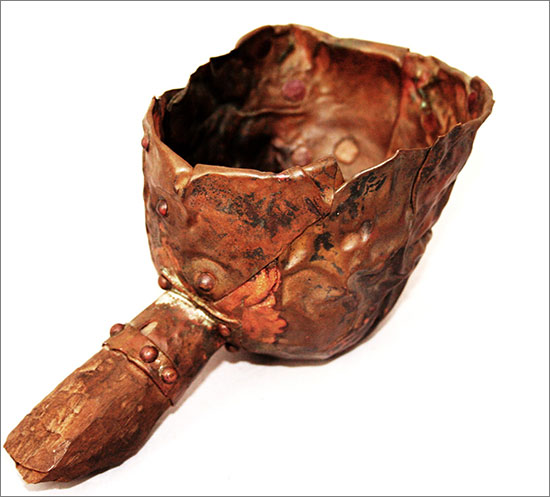Materials: copper and wood
Dimensions: 19cm x 12cm
Vessel formed by folding metal which was hammered and shaped. Rivets used to hold shape and wooden handle held with copper shaft, which was soldered and riveted to vessel. (Note: the handle is cut short which paradoxically allows the otherwise unsteady, dug up vessel to stand up.) (OR)
A copper vessel, revited with wooden handle
Photo credit: Paul Faith
Paul John Faith
London, UK
I studied fine craft design in Belfast, Northern Ireland and found that I was at my best when I was in an experimental, playful mood. Someone once said, “There are no accidents in ‘Art’”. That was a turning point for me, as I was always making mistakes and was always beating myself up about it. Now, not only was accidents accepted but I started to encouraged them and even built upon them in my work. I learnt about materials,techniques and processes and then after I mastered them I then broke the rules and enjoyed myself. I love to allow the materials and processes to give direction to my work and I only follow. Nature holds many secrets to good design, I like to walk, draw and explore museums. Growing up and living in Ireland my work is influenced by makeshift pots, dug up vessels and organic forms.I’m only starting to develop my work and I have ambitious plans and ideas that are never ending.
These containers and vessels definitely hold their place in the world of stunning art objects as well as in the world of metalsmithing.
Since the dawn of time humans have created containers to hold things that were important to them, from large vessels to hold food and harvests to intimate containers for small precious things. They might hold memories, ashes, medicine, beverage, fruit or food - but all spring from the imagination and skill of the maker. Some have specific religious functions, some are meant for everyday use. When one thinks of a vessel or container the inclination is to think of something with solid walls - yet many of these works involve the exploration of positive and negative space, and the use of negative space to help create the illusion of the wall of the vessel.
As the world’s largest jewelry related internet site, Ganoksin strives to develop exhibitions showcasing work from around the world. This exhibition was open to all metalsmiths, professional and amateur, advanced and beginner. Participants are from The Netherlands, the USA, Canada, Australia, Costa Rica, the United Kingdom, Israel, Hong Kong, Colombia, Romania, Italy, Ireland, Japan, Malaysia and Denmark. While most of the pieces are by an individual metalsmith, some are collaborations, one of three artists spanning 50 years.
In total 319 artists contributed 729 show pieces for the permanent online exhibition.
Objects in the exhibition include boxes, lockets, urns, ash containers, bowls, wine cups, reliquaries, match holders, vases, teapots, pitchers, sugar bowls, baskets, nests, pillboxes, clutches and a range of sculptural forms. A variety of techniques are showcased covering a wide range of metalsmithing techniques. Materials used include everything from gold and silver to less expensive metals. Ornamentation includes the addition of enamel, chasing and repousse’, gemstones and found objects.
The exhibition was curated by Beth Wicker, President of the North Carolina Society of Goldsmiths in the United States, and Adjunct Instructor at Northeastern Technical College in South Carolina. Director of the exhibition is Hanuman Aspler, founder of The Ganoksin Project, the world’s largest internet jewelry site.
